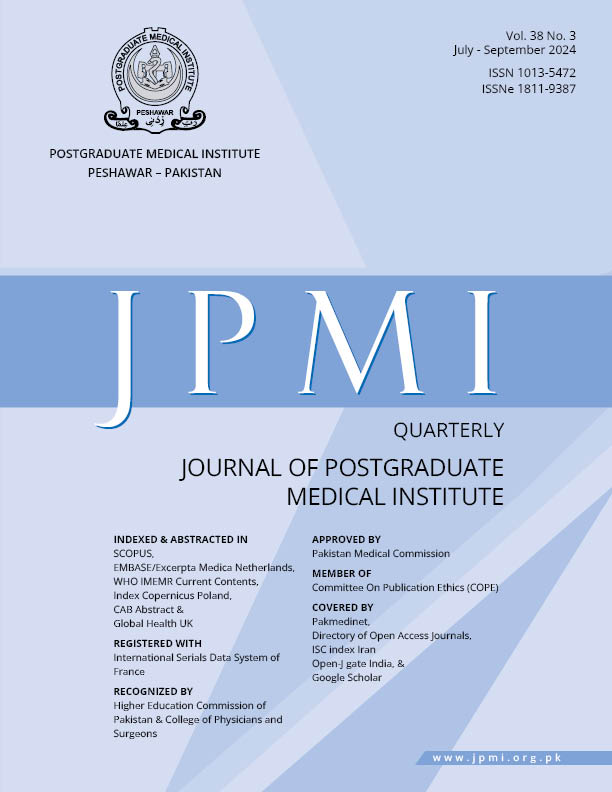Association of Grading of Esophageal Varices with Child Turcotte Pugh Class in Patients of Liver Cirrhosis
Main Article Content
Abstract
Objective: To determine the association between the Child Turcotte Pugh class and the esophageal variceal grade in pediatric patients with liver cirrhosis.
Methodology: This was a cross-sectional study spanning from December 2022 to August 2023, involving children of age 4-14 years with liver cirrhosis at the Pediatric Gastroenterology and Hepatology Department, Department of Paediatric, Combined Military Hospital, Rawalpindi; patients were classified into Child-Pugh-Turcotte Classes A, B, or C based on laboratory and clinical parameters. All underwent upper gastrointestinal endoscopy to screen for varices. Data analysis was performed using SPSS version 20, with a p-value of <0.05 considered significant.
Results: The study involved patients with a mean age of 7.3±3.0 years, 55% male and 45% female. Glycogen Storage Disorder (23%) and Progressive Familial Intrahepatic Cholestasis (17%) were the main causes of liver cirrhosis. Upper gastrointestinal (UGI) endoscopy showed 77.6% had varices, with 30.6% Grade-I and 26.5% Grade-III. Screening for esophageal varices was the most common indication (47%). Among patients with hematemesis, 57% had Grade-III varices, compared to 13% of those screened, 33% with malena, and none with abdominal pain (p=0.03). In the Child-Pugh-Turcotte classification, 42% of Class-A had no varices, while 25% had Grade III; 50% of Class-B had Grade-I, and 40% of Class-C had Grade-III varies (p=0.08).
Conclusion: The Child-Pugh-Turcotte score is a valuable non-invasive tool for assessing morbidity and mortality in pediatric liver cirrhosis. It effectively stratifies patients based on variceal presence and grade, aiding in clinical management and outcome prediction. Routine use of this score can improve prognostic accuracy and treatment planning for these patients.
Article Details
Work published in JPMI is licensed under a
Creative Commons Attribution-NonCommercial 2.0 Generic License.
Authors are permitted and encouraged to post their work online (e.g., in institutional repositories or on their website) prior to and during the submission process, as it can lead to productive exchanges, as well as earlier and greater citation of published work.
References
Gupte GL, Srivastava A. Chronic Liver Disease in Children: From Diagnosis to Liver Transplantation. Indian J Pediatr. 2024;91(3):260-1. DOI: 10.1007/s12098-024-05030-3.
Kehar M, Griffiths R, Flemming JA. Increasing incidence of cirrhosis over the past 2 decades among children in Ontario, Canada. Am J Gastroenterol. 2022;117(1):189-92. 10.14309/ajg.0000000000001564.
Herrmann J, Petit P, Grabhorn E, Lenz A, Jürgens J, Franchi-Albella S. Liver cirrhosis in children - the role of imaging in the diagnostic pathway. Pediatr Radiol. 2023;53(4):714-26. DOI: 10.1007/s00247-022-05480-x.
Mazumder MW, Benzamin M. Upper gastrointestinal bleeding in Bangladeshi children: Analysis of 100 cases. World J Gastrointest Endosc. 2024;16(1):44-50. DOI: 10.4253/wjge.v16.i1.44.
Borhani A, Luu H, Mohseni A, Xu Z, Shaghaghi M, Tolosa C. Screening for exclusion of high-risk bleeding features of esophageal varices in cirrhosis through CT and MRI. Clin Imaging. 2024;110:110168. DOI: 10.1016/j.clinimag.2024.110168.
Lesmana CRA, Raharjo M, Gani RA. Managing liver cirrhotic complications: Overview of esophageal and gastric varices. Clin Mol Hepatol. 2020;26(4):444-60. DOI: 10.3350/cmh.2020.0022.
Raj A, Pillai G, Divakar A, Shivam V, Nair A. Association of Thyroid Function and Severity of Illness in Liver Cirrhosis as Measured by Child-Pugh Score. Cureus. 2023;15(3):e36618. DOI: 10.7759/cureus.36618.
Tarar ZI, Farooq U, Gandhi M, Saleem S, Daglilar E. Safety of endoscopic retrograde cholangiopancreatography (ERCP) in cirrhosis compared to non-cirrhosis and effect of Child-Pugh score on post-ERCP complications: a systematic review and meta-analysis. Clin Endosc. 2023;56(5):578-89. DOI: 10.5946/ce.2023.027.
Girish A, Shrestha TM. Child Pugh Score as a Predictor of Large Oesophageal Varices in Chronic Liver Disease Patients. Nep Med J. 2020;3(1):37-41.
Rahmani P, Farahmand F, Heidari G, Sayarifard A. Noninvasive markers for esophageal varices in children with cirrhosis. Clin Exp Pediatr. 2021;64(1):31-6. DOI: 10.3345/cep.2019.01599.
Lopes JR, Ferreira AR, Liu PM, Queiroz TC, Fagundes ED, Pimenta JR, et al. Non-invasive predictors of esophageal varices with a high risk of bleeding in pediatric cirrhotic patients. J Pediatr Gastroenterol Nutr. 2021;72:802–6.
Roy U, Mondal A, Rukunuzzaman M. Assessment of Chronic Liver Disease (CLD) Based on Esophageal Varices in Children. Asian J Pediatr Res. 2023;13(4):90-8. DOI: 10.9734/ajpr/2023/v13i4295.
Dehghani SM, Rashidinia Z, Shahramian I, Bazi A, Saeed A, Shorafa E. Risk Factors of Esophageal Bleeding in Children with Various Etiologies of Liver Cirrhosis–A Single-Center Report from Iran. Serb J Exp Clin Res.2019;23(2):135-40. DOI: 10.2478/sjecr-2019-0049.
Altamimi E, Odeh Y, Al-Quraan T, Mohamed E, Rawabdeh N. Diagnostic yield and appropriate indication of upper endoscopy in Jordanian children. BMC Pediatr. 2021;21(1):10. DOI: 10.1186/s12887-020-02470-6.
Wani MA, Zargar SA, Yatoo GN, Haq I, Shah A, Sodhi JS, Gul, et al. Endoscopic Yield, Appropriateness, and Complications of Pediatric Upper Gastrointestinal Endoscopy in an Adult Suite: A Retrospective Study of 822 Children. Clin Endosc. 2020;53(4):436-42. DOI: 10.5946/ce.2019.118.
Fagundes ED, Ferreira AR, Roquete ML, Penna FJ, Goulart EM, Figueiredo Filho PP, et al. Clinical and laboratory predictors of esophageal varices in children and adolescents with portal hypertension syndrome. J Pediatr Gastroenterol Nutr. 2008;46(2):178-83. DOI: 10.1097/MPG.0b013e318156ff07.


